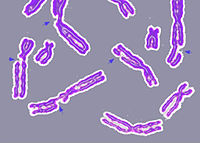
MRI Is a DNA Damage Response Adaptor during Classical Non-homologous End Joining.
Sign Up to like & getrecommendations! Published in 2018 at "Molecular cell"
DOI: 10.1016/j.molcel.2018.06.018
Abstract: The modulator of retrovirus infection (MRI or CYREN) is a 30-kDa protein with a conserved N-terminal Ku-binding motif (KBM) and a C-terminal XLF-like motif (XLM). We show that MRI is intrinsically disordered and interacts with… read more here.
Keywords: end joining; dna damage; damage response; classical non ... See more keywords

Focus on the classical and non-classical functions of EZH2: Guide the development of inhibitors and degraders.
Sign Up to like & getrecommendations! Published in 2022 at "Pharmacological research"
DOI: 10.1016/j.phrs.2022.106159
Abstract: Enhancer of zeste homologue 2 (EZH2, also known as KMT6A) is found to be a member of the histone lysine methyltransferase family. An increasing number of studies have shown that in addition to methylating histones,… read more here.
Keywords: classical functions; focus classical; classical non; functions ezh2 ... See more keywords

Revising CX3CR1 Expression on Murine Classical and Non-classical Monocytes
Sign Up to like & getrecommendations! Published in 2020 at "Frontiers in Immunology"
DOI: 10.3389/fimmu.2020.01117
Abstract: In mice, monocytes (Mo) are conventionally described as CX3CR1low classical Mo (CMo) and CX3CR1high non-classical Mo (NCMo) based on the expression of EGFP in Cx3cr1+/EGFP mice and by analogy with human CX3CR1 expression. Although this… read more here.
Keywords: classical non; cx3cr1; non classical; expression ... See more keywords

Mutational phospho-mimicry reveals a regulatory role for the XRCC4 and XLF C-terminal tails in modulating DNA bridging during classical non-homologous end joining
Sign Up to like & getrecommendations! Published in 2017 at "eLife"
DOI: 10.7554/elife.22900
Abstract: XRCC4 and DNA Ligase 4 (LIG4) form a tight complex that provides DNA ligase activity for classical non-homologous end joining (the predominant DNA double-strand break repair pathway in higher eukaryotes) and is stimulated by XLF.… read more here.
Keywords: dna; xlf; dna bridging; xrcc4 xlf ... See more keywords